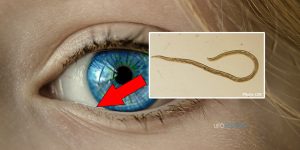Susan Perry of the Minnesota Post reports an Oregon woman is the first known person to become infected with a tiny parasitic worm that lives in the eyes of cattle, according to a case study report published Monday by researchers at the Centers for Disease Control and Prevention (CDC).
 Although common in animals, eye-worm infections in humans are extremely rare. And, if caught and treated early, they don’t cause any permanent damage to the eye.
Although common in animals, eye-worm infections in humans are extremely rare. And, if caught and treated early, they don’t cause any permanent damage to the eye.
“This is only the 11th time a person has been infected by eye worms in North America,” lead author Richard Bradbury, who heads the CDC’s Parasite Diagnostics and Biology Laboratory, told CNN. “But what was really exciting it that it is a new species that has never infected people before. It’s a cattle worm that somehow jumped into a human.”
The woman, 28-year-old Abby Beckley, was working on a salmon boat in Alaska two summers ago when her left eye became irritated and inflamed. A week later, when the symptoms didn’t go away, she decided to investigate.
BuzzFeed reporter Nidhi Subbaraman, who interviewed Beckley, describes what happened next:
Standing at the mirror in the galley, [Beckley] plucked at her eyeball, as if extracting a contact lens.
“I put my fingers in there in kind of a picking motion and I pulled out a worm,” Beckley [said]. “I looked at my finger and it was moving and I was shocked.”
Beckley said she woke up her bunkmate to show her the worm, a piece of tangled white fluff wriggling at the end of her index finger. “She confirmed I wasn’t crazy,” Beckley said.
Over the course of the next few days she pulled out about a half dozen more worms. “I was living with these things, and I’d just keep pulling them out when I’d feel them,” Beckley said.
Beckley flew home and went to see specialists at the Oregon Science and Health Laboratory in Portland. They extracted two more worms, and sent one to the CDC for analysis. It was identified as being the nematode Thelazia gulosa, which commonly infects the eyes of cattle, but had never been found in humans.
The case report was published online in the American Journal of Tropical Medicine and Hygiene, where it can be read in full.
